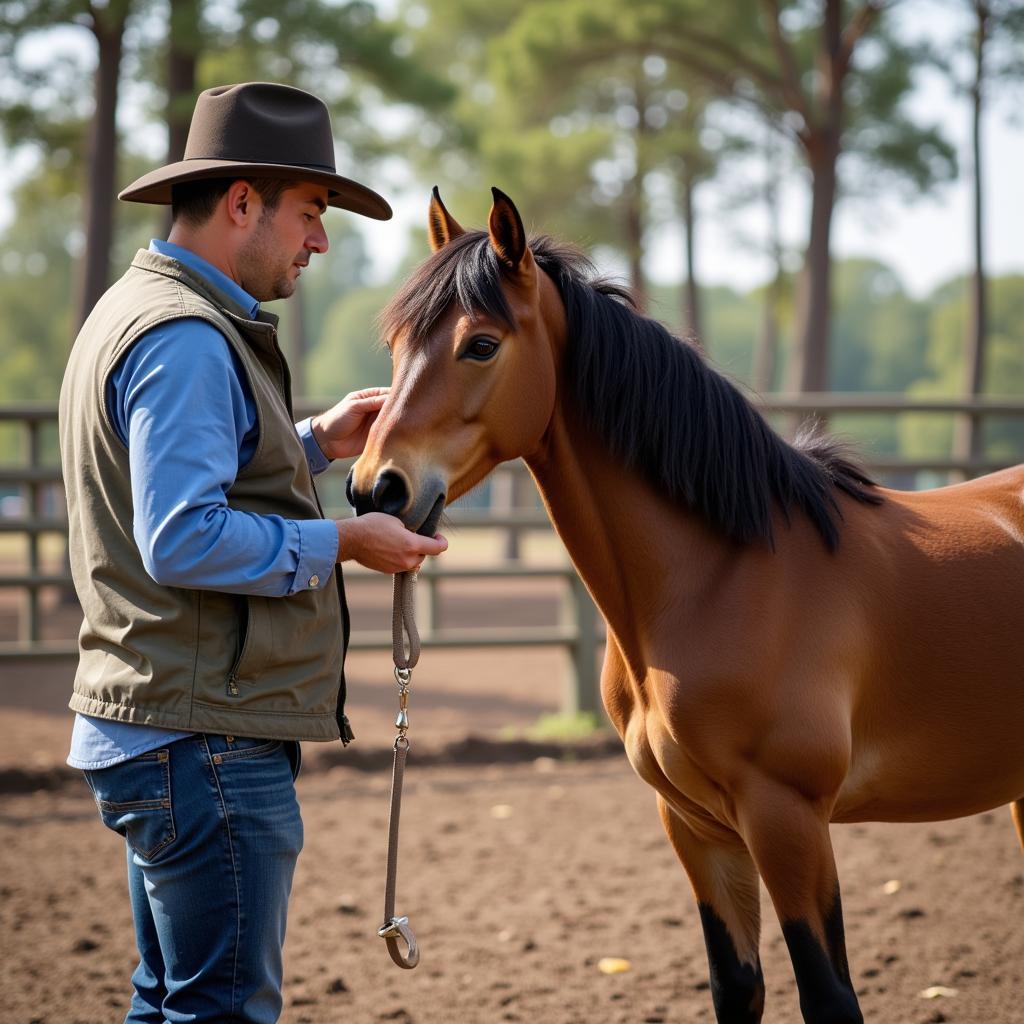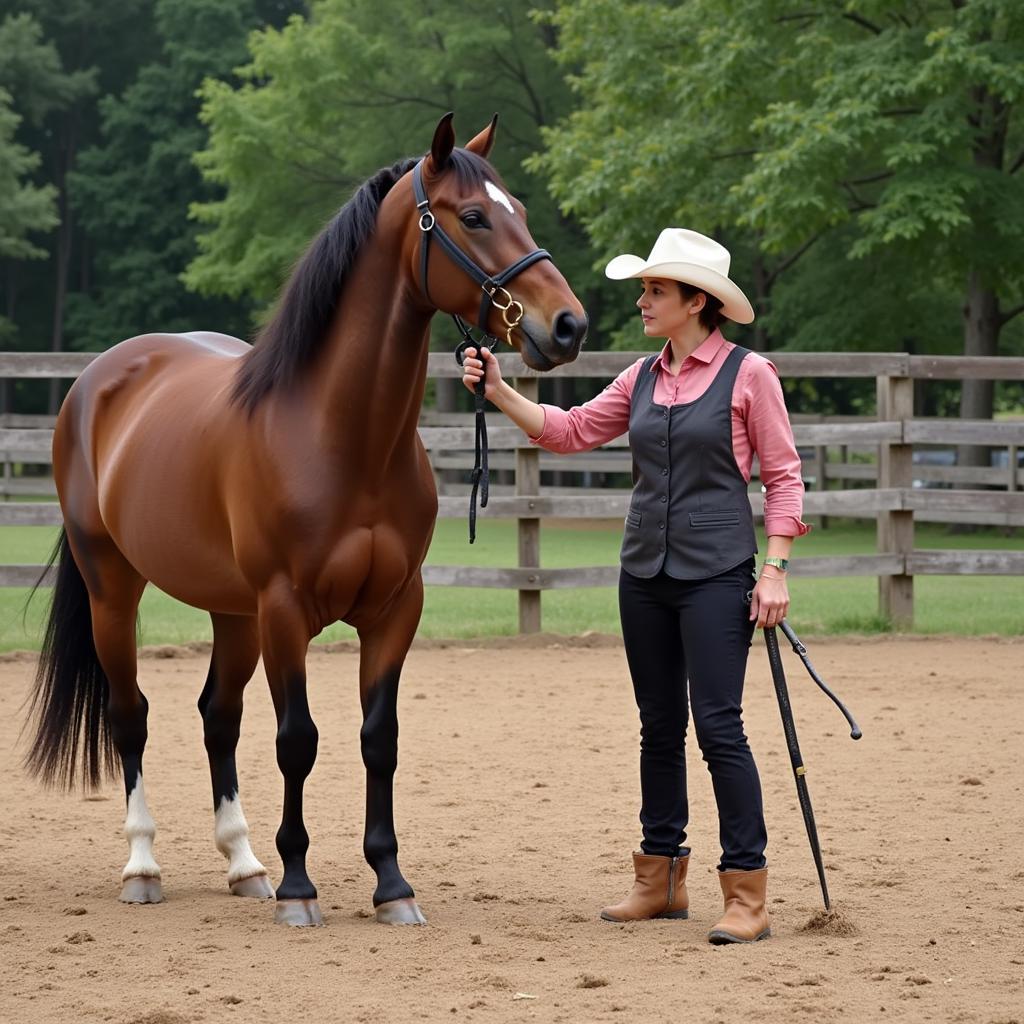The term “Bad Monkey Horse” might sound strange at first, but it describes a very real and potentially dangerous behavior pattern in horses. While horses are inherently prey animals with a strong flight instinct, some individuals develop aggressive tendencies that manifest as biting, kicking, charging, or other forms of threatening behavior. These horses are often labeled as “bad monkeys” due to their unpredictable and seemingly malicious actions.
Unraveling the Causes of “Bad Monkey” Behavior
It’s crucial to understand that horses, unlike monkeys, don’t act out of malice. Their behavior, even when aggressive, is usually a response to fear, pain, discomfort, or learned behavior. Here are some common factors that contribute to a horse developing “bad monkey” tendencies:
- Early Handling and Training: Horses that experience inconsistent, harsh, or abusive handling during their formative years are more likely to develop behavioral issues, including aggression.
- Pain or Discomfort: A horse experiencing physical pain or discomfort from ill-fitting tack, dental problems, or underlying medical conditions might react aggressively as a way of communicating its distress.
- Learned Behavior: Horses are quick learners. If they discover that certain behaviors, like biting or kicking, result in a desirable outcome—like being left alone or getting a treat—they are likely to repeat them.
- Hormonal Imbalances: Hormonal fluctuations, particularly in stallions and mares, can influence behavior and increase the likelihood of aggression.
- Genetic Predisposition: While not the sole determinant, some breeds might be genetically predisposed to certain temperaments, making them more prone to developing “bad monkey” behavior if not handled and trained appropriately.
 A young horse being trained with a handler
A young horse being trained with a handler
Identifying the Signs: Is Your Horse a “Bad Monkey”?
Recognizing the signs of a “bad monkey” horse is vital for ensuring the safety of both handlers and the horse itself. While some signs are overt, others are more subtle and require careful observation. Here are some key indicators to watch out for:
- Ears Pinned Back: One of the most universal signs of aggression in horses is pinning their ears flat against their head. This is often accompanied by a tense facial expression and a raised head.
- Biting or Mouthing: A “bad monkey” horse might nip, bite, or try to mouth at handlers or other horses. This behavior can range from playful nips to dangerous bites.
- Kicking: Kicking is a serious sign of aggression in horses and can cause severe injury. “Bad monkey” horses might kick out with their hind legs when approached, handled, or ridden.
- Charging: Some “bad monkey” horses might charge at people or other animals, often with their ears pinned back and teeth bared.
- Unpredictable Behavior: One of the hallmarks of a “bad monkey” horse is its unpredictable nature. They might seem calm one moment and then suddenly lash out without warning.
Addressing the Issue: Dealing with a “Bad Monkey” Horse
If you suspect your horse is exhibiting “bad monkey” behavior, it’s essential to address the issue promptly and effectively. Remember, punishment is rarely the answer and can often exacerbate the problem. Instead, focus on:
- Veterinary Evaluation: Rule out any underlying medical conditions or pain as a contributing factor to the behavior.
- Experienced Trainer: Consult with a qualified equine behaviorist or trainer experienced in dealing with aggressive horses. They can assess the situation and develop a tailored training plan.
- Positive Reinforcement: Use positive reinforcement techniques, such as clicker training, to reward desired behaviors and build trust.
- Desensitization and Counter-Conditioning: Gradually desensitize the horse to triggers that elicit aggressive responses and counter-condition them to associate these triggers with positive experiences.
- Management Strategies: Implement management strategies to minimize the risk of dangerous situations, such as using protective gear when handling the horse and avoiding situations that are known to trigger aggressive behavior.
 Experienced trainer using positive reinforcement techniques with a horse
Experienced trainer using positive reinforcement techniques with a horse
Conclusion: Turning the “Bad Monkey” Around
While the term “bad monkey horse” might conjure up images of an inherently malicious animal, it’s crucial to remember that these horses are often reacting to fear, pain, or learned behavior. By understanding the underlying causes, recognizing the signs, and implementing appropriate training and management strategies, it’s possible to modify these behaviors and help the horse become a safe and willing partner. Remember, patience, consistency, and professional guidance are key to turning a “bad monkey” into a well-adjusted equine companion.
FAQs about “Bad Monkey” Horses
1. Can any breed of horse become a “bad monkey”?
While some breeds might have temperaments that make them more prone to certain behaviors, any horse, regardless of breed, can develop “bad monkey” tendencies if exposed to the wrong environment or handling.
2. Is it safe to keep a “bad monkey” horse?
The safety of keeping a “bad monkey” horse depends on the severity of the behavior, the owner’s experience, and the availability of professional help. In some cases, with proper training and management, these horses can become safe companions. However, in other situations, rehoming might be the most responsible decision.
3. Can “bad monkey” behavior be cured?
While it’s not always possible to completely “cure” behavioral issues, with consistent training, positive reinforcement, and professional guidance, significant improvements can be made.
4. How long does it take to rehabilitate a “bad monkey” horse?
The time it takes to rehabilitate a “bad monkey” horse varies depending on the severity of the behavior, the horse’s individual temperament, and the effectiveness of the training program. It can take months or even years of consistent effort.
5. What should I do if my horse displays “bad monkey” behavior?
If your horse displays “bad monkey” behavior, the first step is to consult with your veterinarian to rule out any underlying medical conditions. Next, seek help from a qualified equine behaviorist or trainer experienced in dealing with aggressive horses. They can assess the situation and develop a safe and effective training plan.
Need Help with your Horse? Contact Justus Horses USA at 0772127271 or [email protected]. Our team of equine experts is available 24/7 to provide guidance and support. You can also visit us at QGM2+WX2, Vị Trung, Vị Thuỷ, Hậu Giang, Việt Nam.